SCENT TOOLS
SCENT SLEEVE OR SCENT PUMP (1977)
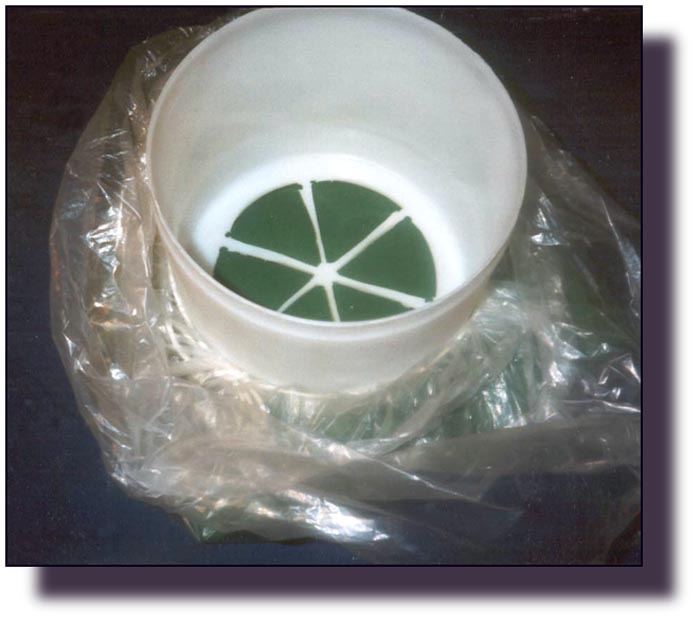
October 20, 1977 - Cheektowaga, N.Y. A Police Officer is shot and killed at the Airport Holliday
Inn at 0055 hours. This started one of the biggest manhunts in the area's history. Hundreds of
Police Officers from 11 different agencies, shepherds and Bloodhounds from several departments
responded to the scene. All dogs used at this scene were ineffective because the one peice
of scent material available was contaminated inadvertently by the first dog handler.
Immediately after this case, I developed the scent sleeve in an effort to help protect and preserve
scent material when it's going to be used by multiple dogs or dog handlers.
This I found allowed me to start a number of dogs on one piece of Scent Material without
contaminating the scent article.
BIG T TRAINING AIDS
BIG T TRAINER (1986)
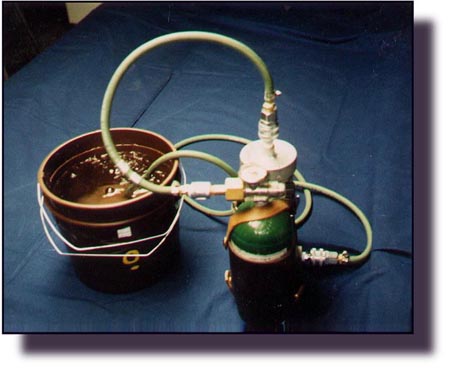
I found this to be a very versatile training tool. A scent article placed in one container and then
clean air blown over the scent article with only the air used for the dog to work on. The scent
article could be anything such as Narcotics, Accelerants, Human Scent, Cadaver or whatever.
Another advantage was there is no article or visual item for the dog to condition on, only the
scent itself was present.
Air containing cadaver scent was blown into buckets of water and the dog had to pick out
the right bucket that had the Cadaver scent from a half dozen buckets. This was later transferred
to holes in ice allowing us to check for a victim under ice. The dog would walk along and check
the holes just like he did with the buckets.

With slight modifications this was fasten to the sides of a John Boat and used to train for bodies
under water. One of the advantages was that we could use a dye with this system enabling us to
see where the scent was in the water.
STU-100 (1991)

I have worked for many years trying to develop a procedure to be able to control the movement
and collection of scent.
In 1977 I tried moving scent by using a pumping action to move the scent up into
a receptacle above the scent article so multiple dogs could be scented from an article without
contaminating the original scent article itself.
Then in the 80'S I tried moving air under pressure over and around a scent article
as shown in the big T Trainer.
Finally in the late 80'S I tried using a vacuum process to collect the
scent into a sterile gauze pad that I could move around and better yet, I could collect the scent
and keep it for long periods of time.
A number of 110 models were tested. I called them "Scent Transfer Machines" however
as with most first inventions they were big, heavy, cumbersome and while they did the job well
they were difficult to handle.
Finally I got a 12 volt System Developed that worked and it was small, Light, Portable
and easy to use. With the help of my partner Larry Harris who redesigned the hood for the
machine we had it patented and the STU-100 became the unit of choice.
The Invention and use of the STU-100 , The worlds first Scent
Transfer Unit, allows you to do things with scent evidence never before possible.
You are able to move the Scent Evidence out of the evidence locker and into the Scent Bank, which will reduce the risk of environmental contamination and extend the life and quality of the scent pad or
article in long term storage.
BIG T (accellerant) FIELD KIT (2000)
This kit was developed for two reasons.
- The convenience of having everything you need in the field for each training session.
- I was not happy with a passive “sit” alert. I wanted the dog to put his nose on the EXACT spot where the accelerant scent was. Making the dog a more accurate tool and simplifying the sample collection.

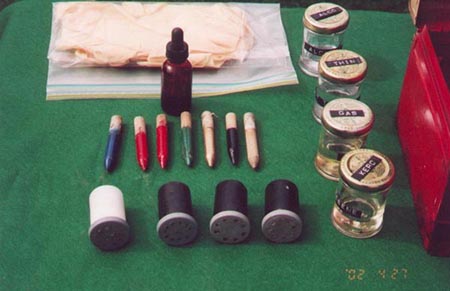
PHOTO 1 Picture of Big T field kit.
PHOTO 2 Contents of Box Rubber gloves,
5 training aids (carried for that training session but not limited just to these samples, Types of samples would vary with each training period.), Small bottle with dropper, Several 7/16 dowels about 3 inches long, color coded with small hole drilled in top of dowel.
Several 35mm film canisters with cotton in them and holes drilled in top.
I also carry 8 or 10 - 1/4 inch rods about 10 inches long with a loop or eye in the top. These are stuck in the ground to designate the search area. Color tape tied in the eye makes them easy to see. These should NOT be carried in the kit box but separately to prevent contaminating the tape or the dogs will hit and alert on your markers.

Take one of your 7/16 dowels with your color coded mark such as red for gas and put one or 2 drops down in the hole at the top of the dowel then shove it down in the ground until it is flush with ground or out of sight. Making sure you can cross reference it’s location with your tape markers or some other means so you can read your dog when he is close and you can reward him. They are difficult for the handler to find so be aware when you put them out.
During that session I will also put out one or more of my 35 mm canisters up in a tree or high ledge 6 feet to 8 feet from ground level for the dog to find. Teaching her to LOOK UP and cast for scent. A free working dog has considerable advantage over the dog on lead on this exercise.
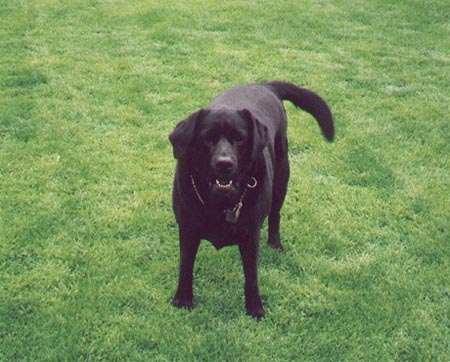
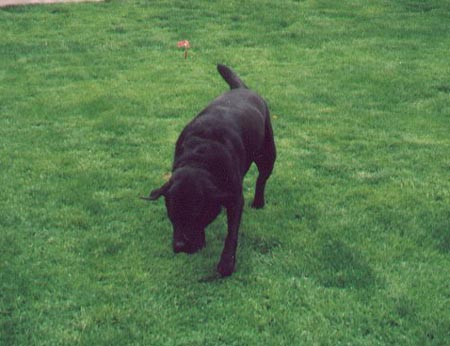
My dog works free when she finds it she will face me, speak and I ask her,
“ Have you got something?” She will come to me, I ask, “show me” I follow her back to the find. When that nose goes down you can reach and feel in the grass and that dowel is always less than one or 2 inches from her indication
When you think the dog and handler are ready to start working cases set up a test area 600 to 800 square feet. Put 2,3 or 4 finds in that area. Then ask the handler to work the area against the clock. In a matter of minutes you can sort out the dogs and handlers that ARE READY TO MOVE ON.
Bill Tolhurst
Copyright © 2000 Home Of The Big T, All Rights Reserved.
Positive Pressure (2001)
I would like to share a brand new procedure I have developed that I believe could save thousands of lives. It is called the "Positive Pressure Air Scent Transfer Procedure"
This is a procedure to locate bombs in schools and other Public building. It enables dog handlers to get much more work from their dogs without burning them out. It will also increase the amount of square footage the dog can work before having to rest.
Let me simplify the basic concept of this procedure. (we will use a school search for an example.)
In the standard accepted search procedure the dog has to detail every item in the room. These classrooms are about 800 square feet in size with six (6) rooms (4800 sq. ft) served by one filter. Constant detailing of each room could take 10 minutes each or 60 minutes for the 4800 square ft.
Note: These times are estimates. Detailing each room could take much longer depending on the amount and kind of materials in the room.
Using the Positive Pressure Air Procedure the dog would be taken directly to that zone filter room and have him check that filter that would take maybe 3 or 4 minutes and he has checked the total 4800 square feet. If the dog alerts on the filter we shut down that zone. Go back and clear these rooms.
If he doesn’t alert 4800 square ft. has been cleared in 3 or 4 minutes.
Implementing this procedure has one prerequisite.
It requires some pre-planning of the site and the air system of the building to be searched. The assistance of someone with knowledge of the air system, and site plans that can be studied, will be needed.
There are several different types of Positive Pressure Air Systems in use today. Pre-planning will allow the dog and the handler to work in harmony with that system.
Let me point out here that this procedure is not 100% effective. There can be problems such as:
Repairs and alterations that have created dead air space, such as closing in the area around elevator shafts.
Areas above drop ceilings can contain air that is never available to the dog.
We also discovered other things during our pre-planning and test periods.
In one room where the air handling unit (AHU) was right in the room, we placed 4oz. of gun powder on a shelf in that room. We let the dogs woalk past the AHU and he did not hit the filter. We examined the filter and found it was so thin that it did not even collect any dust. We placed a cloth pad in the front of the unit and the dog hit it immediately. The thin filter was replaced. So faulty filters are a consideration.
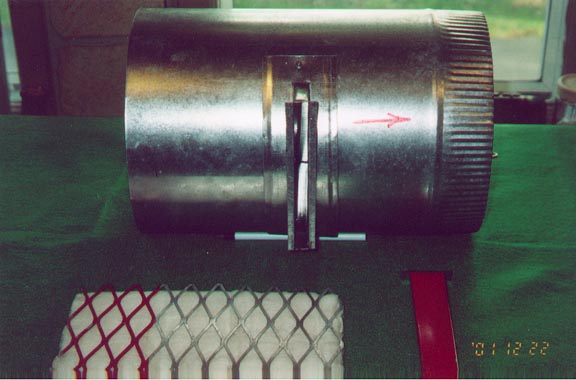
Prototypes of ductwork with removable filters (see photo) have been made that can be put in strategic places to improve the coverage of an existing air system. These can be added to a system at low cost to improve the efficiency of collecting scent as needed. I believe over time this type of approach could produce a nearly fool proof product.









